The James Webb Space Telescope is an unprecedented mission that is on the precipice of seeing the light from the first galaxies and discovering the mysteries of our universe. Each feat already achieved and future accomplishment is a testament to the thousands of innovators who poured their life’s passion into this mission.
—Bill Nelson, NASA administrator
At 7:20 AM, Christmas Day 2021, an Ariane V rocket, with the James Webb Space Telescope folded safely inside its tip, powered away from its launch pad in French Guiana, South America.
It was a historic moment and one which may change the way we understand the universe.
More than 25 years in the making and resulting from multinational cooperation among NASA and the European and Canadian Space Agencies, the James Webb Space Telescope (JWST or simply the “Webb”) has an unprecedented mission: to peer into the depths of time and capture infrared light from the dawn of the universe.
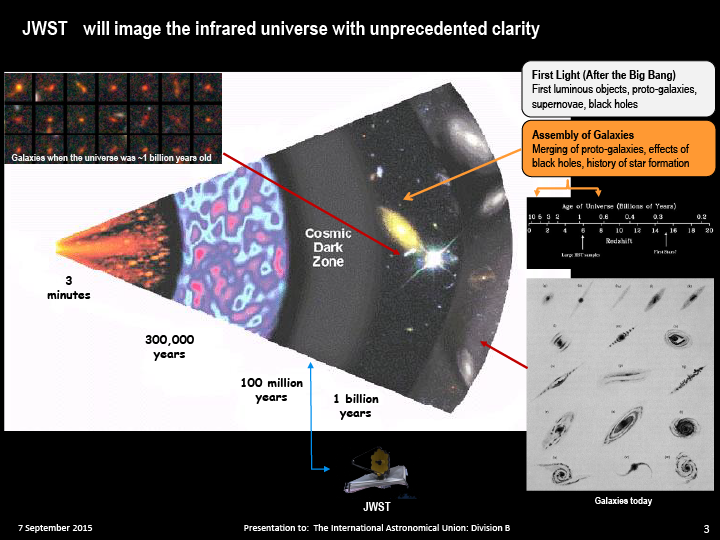
Image: Nasa, https://ntrs.nasa.gov/api/citations/20150021208/downloads/20150021208.pdf p.3
James Webb Space Telescope vs Hubble
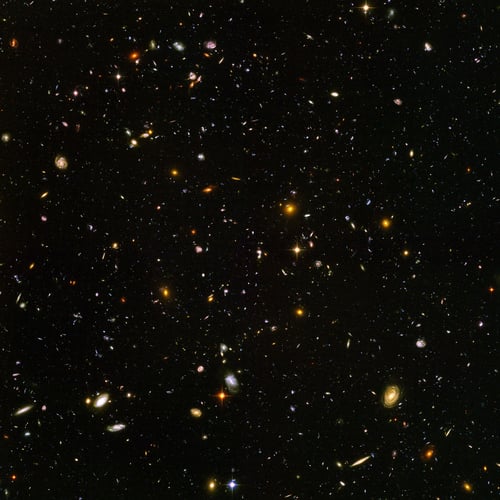
Hubble image of deep space field
Image credit: NASA, ESA, and S. Beckwith (STScI) and the HUDF Team
According to Dr.Brenda Frye, who worked on testing two of the instruments to be used on board the James Webb Space Telescope:
The JWST is the most celebrated telescope in the making. It is the much-touted "replacement" for the aging (26 year old) Hubble Space Telescope, yet this is hardly a fair comparison. The JWST will have seven times the collecting area of its predecessor and more sophisticated instruments which will enable us to see 13 billion years into the past. This is remarkable as the universe is only 13.7 billion years old. A significant challenge arises because unlike the Hubble Space Telescope, the JWST will not be serviceable. It has to survive the agitation of liftoff in a rocket, operate in the bitter cold of space, protect the sensitive astronomical instruments from damaging sunlight, and send data back to Earth on the first try. This is intense.
You can learn more about the complementarity of these two space telescopes from NASA.
The Hubble Space Telescope orbits the earth, but the Webb will orbit the sun at a point nearly a million miles from earth. Its final destination is known as the second Lagrange point, or L2. This special location allows the Webb to maintain its position relative to the earth and sun: their collective gravitational pull will allow it to “keep up” with the earth’s orbit around the sun.
From this vantage point, with a greater resolution than ever before, the Webb will be in an optimal position to capture infrared light from the most distant objects in the universe. In addition, using the most advanced infrared technology, the Webb telescope can penetrate dust clouds around star-forming nebulae, examine exoplanet atmospheres looking for the signatures of life, and offer a close scrutiny of objects in our own solar system.
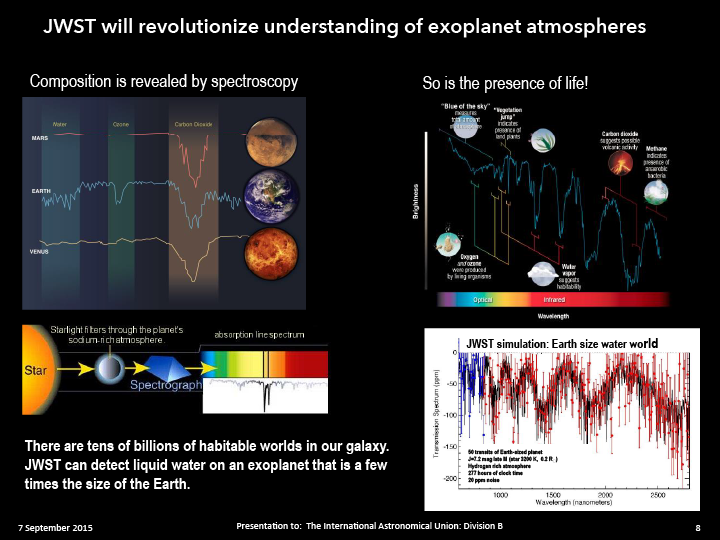
Image credit: Nasa, https://ntrs.nasa.gov/api/citations/20150021208/downloads/20150021208.pdf p.8
What is unique about the James Webb “observatory”?
The hopes and the expectations of Webb are many. In 2015, a presentation to the International Astronomical Union detailed the potential information that Webb will provide to the scientific community and the world. It is worth scrolling through the powerpoint for a potent visual summary of its proposed targets.
Such an unprecedented mission requires unprecedented feats of engineering and an array of specially designed features and instruments. The “insane engineering” of the Webb does not disappoint. Two of its most astounding features are the sunshield and the mirror.
The James Webb Telescope Sun Shield
The Webb and its onboard suite of delicate instruments need to operate at -220 C/-334 F. Because it is meant to detect infrared light from very distant objects, manifested as faint heat signals, Webb needs protection from the heat of the sun, the earth, moon, and even itself! The highly elaborate sunshield passively radiates this heat back into space.
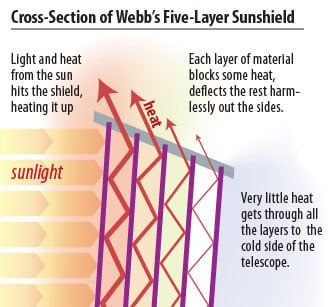
Image credit: STScI
This specialized structure is composed of 5 layers of kapton coated with aluminum. The two layers closest to the sun also have a “doped silicone” coating. Kapton is itself a material science and engineering feat. Developed by Dupont in the 1960’s, kapton remains stable across an extreme range of temperatures: from -269 to + 400 C (-452 to +752 F). Collectively, the 5 layers will maintain close to 600 F difference from the external facing side and the observatory side.
When deployed, the sunshield is about the size of a tennis court, although the size and the thickness of each layer varies. According to NASA:
The telescope optics (like the infrared camera and mirrors) must always be protected from direct exposure to any hot objects. So the membranes are sized and positioned such that the mirrors only have a direct line of sight to the cold Layer 5, while the sun only directly shines on Layer 1 no matter which way the observatory is pointed.
All five layers need to be unfolded perfectly. There are in fact 300 points of failure involved in the unfolding process, so it was not just a sigh but a whoop of relief released by the scientists, engineers, and enthusiasts on January 4 when the sunshield successfully deployed.
Mirror, mirror…
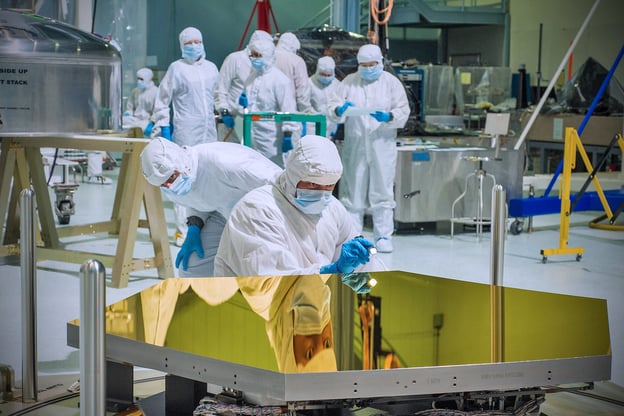
Engineers inspect one of the first two flight mirrors to arrive at NASA Goddard.
Image credit: https://webb.nasa.gov/content/observatory/ote/mirrors/index.html
The Webb’s mirror, at 21 feet in diameter, is the largest telescopic mirror ever launched into space. By comparison, the Hubble Space telescope’s mirror is just under 8 feet.The larger the area of the mirror, the greater the amount of light that it can collect from distant objects, and thus the greater the amount of detail or resolution.
Such a large mirror needed to be both strong and light. The engineers settled on beryllium. Coating the mirror with vaporized gold creates the optimum surface for collecting infrared light.
The details of reflections captured on the surface even while it was in the lab here on earth generated descriptions such as “incredible” and “astounding.”
Its size presented a second problem: how to fit it in a rocket?
The design team found a unique solution.The mirror is composed of 18 hexagonal segments arranged so that two “batwings” could be folded back allowing it to be tucked inside the tip of a rocket. Of course, that means it had to unfold at some point in its journey. This last major deployment occurred over two days, January 7 and 8.
That’s not the end of the story.
These segments need to be aligned precisely so they can act as a single mirror. In the design phase, this created another engineering obstacle:
Aligning the primary mirror segments as though they are a single large mirror means each mirror is aligned to 1/10,000th the thickness of a human hair. What's even more amazing is that the engineers and scientists working on the Webb telescope literally had to invent how to do this.
—Lee Feinberg, Webb Optical Telescope Element Manager, Goddard Space Center
Specialized motors attached to each segment make these extremely precise calibrations. For more information, read the section "Achieving a single focus."
No cameras allowed aboard the James Webb Telescope
Some observers have wondered why there are no observational cameras on board the Webb. Everyone wants to see these marvels up close and in real time!
The engineering team actually had considered using cameras and even performed mock-up configurations. In the end, they decided that the visual information would be lacking in detail, and the very presence of cameras and the heat that they would generate could interfere with the highly controlled working environment.
Instead of cameras, the Webb is outfitted with multiple sensors–mechanical, thermal, and electrical–that allow its handlers to track its health and operational integrity.
These sensors were the source of the “animation” in real time of the unfolding of the giant mirror’s bat wings that occurred Jan. 7-8, as noted above.
James Webb Telescope Orbit - Final Destination L2
The Webb reached its final orbital position, Lagrange Point 2, on January 24, 2022.
Calibration of the onboard instruments, including its high-powered infrared camera is underway but will take months.
Currently, there are multiple updates from the dedicated NASA website, but these are a few highlights.
Update & First Images from the James Webb Telescope
First Image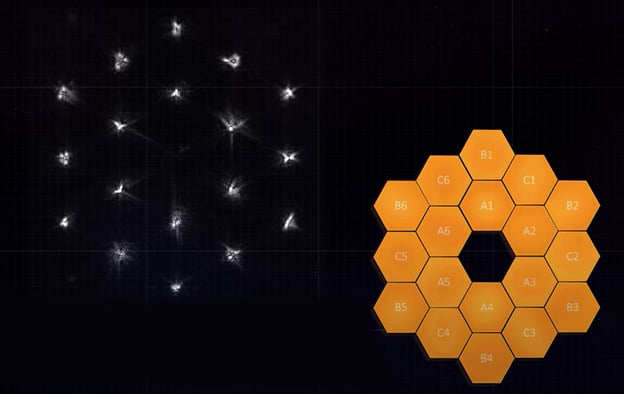
Image credit: NASA/STScI/J. DePasquale
At this time, the Webb has successfully passed through its mirror alignment and cooldown phase and is currently in the segment alignment phase. You may remember that its mirror is constructed of 18 segments, and each of these can be adjusted to collect individual images of a stellar object. Webb team members saw the first photons collected by the telescope and recorded by its near infrared camera (NIRcam). Pointing to a bright isolated star–HD 84006– each of the mirror segments captured a slightly different image.
The following short video summarizes this process. https://www.youtube.com/watch?v=QlwatKpla8s)
The image stacking phase is next on the list in which the 18 images will be compiled to create one image. Full mirror alignment isn’t expected until April and regular science operations are not expected until June.
In the meantime, scientists and the rest of the world are holding a collective breath and cherishing a shared hope that Webb will deliver on its promises.
“The promise of Webb is not what we know we will discover; it’s what we don’t yet understand or can’t yet fathom about our universe. I can’t wait to see what it uncovers!”
—NASA Administrator Bill Nelson.
Feature image credit: Nasa
